Want to learn how to easily make coconut oil at home?
Welcome. This post shows you the easiest virgin, cold press and hot press coconut oil recipe.
Without any further delay, this is how to extract coconut oil from coconut (step-by-step)
How To Make Coconut Oil (Hot Press Method)
Step 1: Get/Buy Coconut
The first and obvious step is to get/buy mature coconuts from the market that looks something like this:
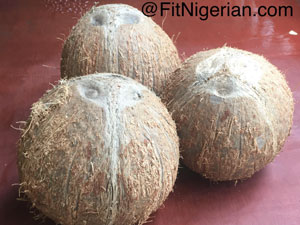
Step 2: Crack Open Coconut
Crack open coconuts by slamming it on a hard surface or by using something hard like a hammer or mallet.
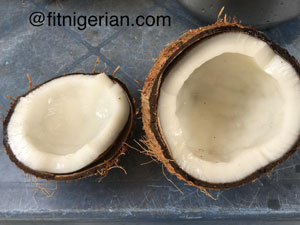
Step 3: Separate Coconut Meat From Shell
Separate coconut meat from the shell by using a knife to remove your coconut from the shell. Then put coconut meat in a bowl and rinse.
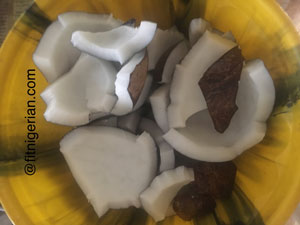
Step 4: Grate Or Scrape Off Coconut Brown skin
You can either grate the coconut using a grater or scrape off the coconut brown back then cut into small bits. If you choose to grate, then you can skip the next step (Step 5).
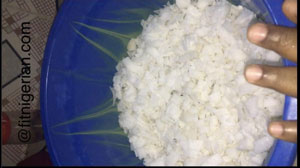
Step 5: Blend Coconut Bits
Put the coconut bits into a blender and add little quantity of water for easy blending. Blend until you get a smooth paste.
Note: If you chose to grate, then no need to blend. You will just soak the grated coconut meat in about 1 to 2 cups of hot water.
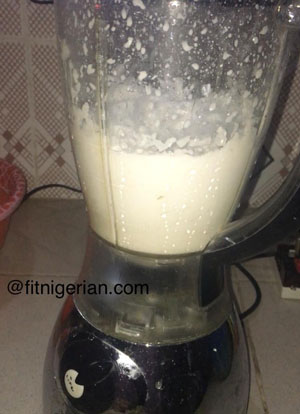
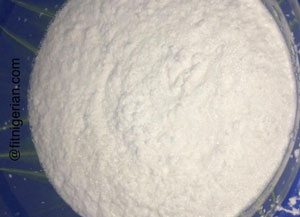
Step 6: Sieve Out Coconut Milk From Shaft
Pour coconut paste or soaked grated coconut meat into a sieve with tiny holes, so that no chaff would pass through. And squeeze as much milk out from the chaff as possible using your hands.
Note: You can pass coconut milk through a chiffon (or cheesecloth) to further filter out tiny particles of coconut chaff.
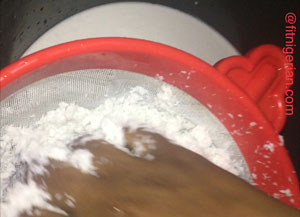
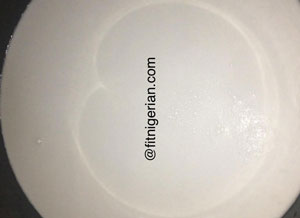
Step 7: Leave Coconut Milk In Freezer Overnight
Put Coconut milk in freezer preferably overnight. So the curds(milky part) will be separated from the water as shown in the picture below:
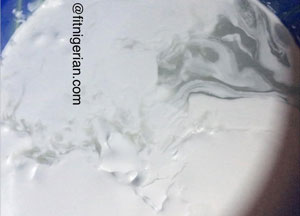
Step 8: Heat Up Coconut Milk
Put the milky part (curd) in a pan and heat on low heat. After heating for a while, the water will begin to evaporate from the coconut milk mixture. The solids begin to shrink while the oil starts to separate from the solids.
Note: This heating process may take a significant amount of time. So you have to be a little bit patient. Also, don't increase the heat. Leave it on low heat because high heat can ruin the oil.
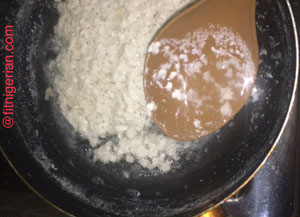
Step 9: Separate Coconut Oil From Solids
When the oil is completely separated from the solid, remove the solids and get rid of them. And allow the oil to cool down then pass through a sieve or cheesecloth to remove any leftover solids or particles.
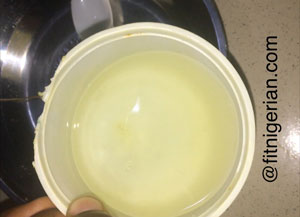
Pour your strained coconut oil into an airtight container and store in a cool dry place.
How To Make Cold Press Coconut Oil
Step 1: Get/Buy Coconut
The first and obvious step is to get/buy mature coconuts from the market
Step 2: Crack Open Coconut
Crack open coconuts by slamming it on a hard surface or by using something hard like a hammer or mallet.
Step 3: Separate Coconut Meat From Shell
Separate coconut meat from the shell by using a knife to remove your coconut from the shell. Then put coconut meat in a bowl and rinse.
Step 4: Grate Or Scrape Off Coconut Brown skin
You can either grate the coconut using a grater or scrape off the coconut brown back then cut into small bits.
Note: If you choose to grate, then you will just soak the grated coconut meat in about 1 to 2 cups of water. You can skip the next step (Step 5) because no need to blend.
Step 5: Blend Coconut Bits
Put the coconut bits into a blender and add little quantity of water for easy blending. Blend until you get a smooth paste.
Step 6: Sieve Out Coconut Milk From Shaft
Pour coconut paste or soaked grated coconut meat into a sieve with tiny holes, so that no chaff would pass through. And squeeze as much milk out from the chaff as possible using your hands.
Note: You can pass coconut milk through a chiffon (or cheesecloth) to further filter out tiny particles of coconut chaff.
Step 7: Leave Coconut Milk For Up To 24 Hours To Separate
Put the coconut milk in a nylon that’s pointed and leave hanging somewhere in your kitchen for a couple of hours or at most 24 hours.
When you come back, you would see that there are three layers: The water which is beneath, followed by the unrefined virgin coconut oil and then fermented solid curd part on top.
Step 8: Separate Coconut Oil From Solids & Water
You can either puncture holes at the middle point where you clearly see oil so the oil will sip out into a container underneath the nylon.
Or you can put the nylon containing the coconut oil mixture into the refrigerator undisturbed for the top part to freeze up, so you can easily separate your oil.
Step 9: Store Coconut Oil
Pour your strained coconut oil into an airtight container and store in the refrigerator for future use.
Frequently Asked Questions (FAQ)
Here are some of the frequently asked questions about making coconut oil:
How do I recognize a mature coconut?
You would know a mature coconut from the shell; when the shell is dark. Also, another way is if the coconut water is sweet and it’s easy to separate the coconut meat from the shell.
I don’t have a refrigerator, how do I go about extracting my coconut oil?
Not having a refrigerator doesn’t hinder the extraction process. When it’s time to leave your coconut milk overnight, just make sure you place it in a dry place and by the next day, the curds would have separated from the water. In storing your coconut oil, store in a cool dry place as well.
What should I do if after leaving my coconut milk overnight, and it doesn’t solidify or it just forms a thick white curd or just caked?
It’s totally fine when it cakes or a thick white curd forms. The next step is to separate that white curd and put in an appropriate pan for either heating or cold press.
What makes some coconut oils clear and others golden brown?
Well, the answer lies in the amount of heat used in extracting your coconut oil. The longer the heating time, the more the caramelisation, and the browner it gets. And vice versa. Cold-press coconut oils are the clearest because no heat is used in the extraction process.
Is the leftover coconut water still useful?
The leftover coconut water is useful. Well, you can get creative with the leftover water. It can be used for cooking or making smoothies. You can also use the coconut water to make “coconut water kefir” that’s packed with nutrients and is a probiotic.
Homemade Coconut Oil Recipe (Hot-pressed)
Coconut oil recipeRecipe by Fitnigerian.com This coconut oil recipe shows you a quick rundown of how to make coconut oil using the hot press method. 4.5 from 18 reviews 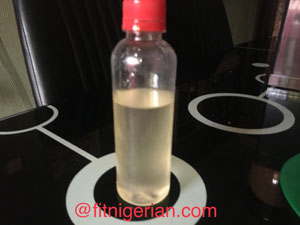 | |||||||||||||||||||||||||||||||||||||||||||||
|---|---|---|---|---|---|---|---|---|---|---|---|---|---|---|---|---|---|---|---|---|---|---|---|---|---|---|---|---|---|---|---|---|---|---|---|---|---|---|---|---|---|---|---|---|---|
Category: Method: Cuisine: | |||||||||||||||||||||||||||||||||||||||||||||
Yields Prep Time Total Time | |||||||||||||||||||||||||||||||||||||||||||||
Ingredients: | |||||||||||||||||||||||||||||||||||||||||||||
Directions:
| |||||||||||||||||||||||||||||||||||||||||||||
Video: | |||||||||||||||||||||||||||||||||||||||||||||
Notes: | |||||||||||||||||||||||||||||||||||||||||||||
NUtrition: | |||||||||||||||||||||||||||||||||||||||||||||
Sources include: USDA Share this recipe:Related Keywords: Cold press, Hot press, Virgin | |||||||||||||||||||||||||||||||||||||||||||||
Homemade Coconut Oil Recipe (Cold-pressed)
Category: Method: Cuisine: | |
Yields Prep Time Total Time | |
Ingredients: | |
Directions:
| |
Video: | |
Share this recipe:Related recipes |
Summary
Homemade Coconut oil (in easy 9 steps)
Looking for how to make coconut oil at home? This step-by-step post shows the easiest & fastest way to make virgin, cold press & hot press coconut oil recipe.
Type: oil
Cuisine: Global
Keywords: Cold press, Hot press, Virgin
Recipe Yield: 50 ml
Calories: 400
Preparation Time: PT0H15M
Cooking Time: PT2H0M
Total Time: PT2H15M
Recipe Ingredients:
- 3 Coconuts (Matured)
- 2 Cups of Water
4.5
Your Turn
Let me know in the comment section which of the coconut oil recipe you'll be making first.

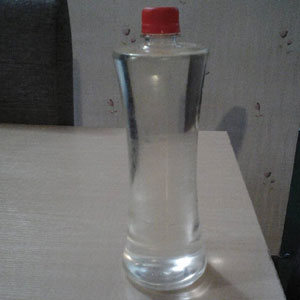
Nice Blog! The information you have provided is incredibly detailed and insightful.
Thanks for this cold press method
But the oil it produces is small compare to the heat method
Wow am amazed at this. Thanks a lot